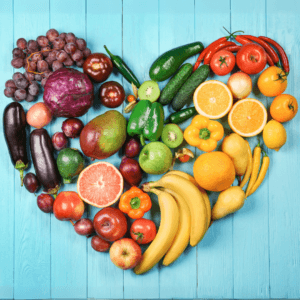 You likely already know that adding vibrant colors to your plate in the form of fresh fruits and veggies can do wonders for your health. Study after study has proven that eating a variety of colorful produce is linked to reduced risk of chronic diseases and improved overall well-being. However, did you know that each specific color of fruits and veggies has specific health benefits?
You likely already know that adding vibrant colors to your plate in the form of fresh fruits and veggies can do wonders for your health. Study after study has proven that eating a variety of colorful produce is linked to reduced risk of chronic diseases and improved overall well-being. However, did you know that each specific color of fruits and veggies has specific health benefits?
By adopting a “rainbow diet” – a diet that represents a spectrum of colors (from natural plants, of course) – you can harness the unique benefits of nature’s diverse nutrients.
Let’s explore the science behind the rainbow diet, the benefits of each color, and how you can incorporate them into your daily meals.
Why Eating the Rainbow Matters
Each color in fruits and vegetables represents different phytonutrients, which are natural compounds that protect us from cell damage and disease. For example, lycopene in red foods supports heart health, while anthocyanins in blue and purple foods promote brain function.
Phytonutrients found in colorful foods also play a role in preventing chronic conditions such as heart disease, diabetes, and certain cancers. For instance, a study published in The American Journal of Clinical Nutrition found that higher consumption of colorful produce is linked to reduced inflammation and improved cardiovascular health.
The Health Benefits of Each Color
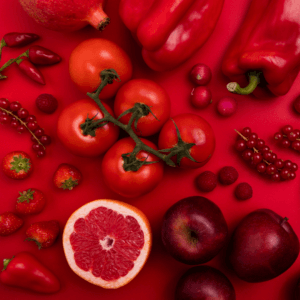 Red Foods
Red Foods
Rich in lycopene, anthocyanins, and vitamin C, red foods are powerful allies for heart health, cancer prevention, and skin vitality.
Lycopene is primarily what gives red fruits and vegetables their color. It is a potent antioxidant high in tomatoes, watermelon, and red grapefruit, and has been shown to reduce the risk of prostate cancer and protect against sun damage to the skin.
Anthocyanins can also give certain produce a red color, such as strawberries and cherries. These provide potent anti-inflammatory benefits and help improve vascular function.
A 2017 study highlighted that regular consumption of red fruits and vegetables is linked to improved blood flow and reduced arterial stiffness. These benefits make red foods particularly important for maintaining cardiovascular health and promoting healthy aging.
Additionally, vitamin C in red bell peppers and raspberries boosts immunity and supports collagen production for glowing skin.
Examples: Tomatoes, strawberries, cherries, red bell peppers, raspberries, watermelon, cranberries, pomegranates, radishes, and red grapes.
Key Nutrients: Lycopene, anthocyanins, vitamin C.
How to Incorporate Red Foods into Your Diet:
- Add sliced tomatoes and red peppers to sandwiches or salads.
- Snack on a handful of cherries or raspberries.
- Blend watermelon and strawberries for a refreshing smoothie.
Orange and Yellow Foods
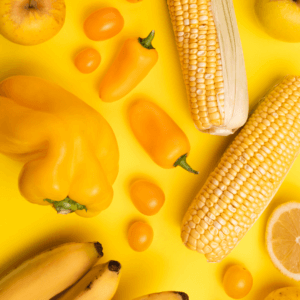 Bursting with beta-carotene, vitamin C, and flavonoids, orange and yellow foods support eye health, immunity, and skin repair.
Bursting with beta-carotene, vitamin C, and flavonoids, orange and yellow foods support eye health, immunity, and skin repair.
Beta-carotene is responsible for the orange and yellow color, such as in carrots, sweet potatoes, butternut squash, mangoes and oranges. The body converts this beta-carotene into vitamin A, which plays a vital role in maintaining good vision and a healthy immune system.
Mangoes and orange peppers are especially packed with vitamin C, known to enhance collagen production, support wound healing, and protect against oxidative stress. Flavonoids in orange and yellow peppers and peaches have been shown to reduce inflammation and support brain health.
Research indicates that diets rich in carotenoids from orange and yellow foods may reduce the risk of age-related macular degeneration, a leading cause of vision loss in older adults.
Furthermore, these foods contribute to radiant skin by neutralizing free radicals and promoting hydration.
Examples: Carrots, oranges, sweet potatoes, mangoes, butternut squash, yellow peppers, apricots, pineapple, peaches, and papaya.
Key Nutrients: Beta-carotene, vitamin C, flavonoids.
How to Incorporate Orange and Yellow Foods Into Your Diet:
- Roast sweet potatoes or butternut squash as a side dish.
- Enjoy fresh mango or pineapple as a mid-day snack.
- Add shredded carrots or sliced yellow peppers to wraps and stir-fries.
Green Foods
 Green vegetables and fruits are nutritional powerhouses rich in chlorophyll, lutein, folate, and vitamin K.
Green vegetables and fruits are nutritional powerhouses rich in chlorophyll, lutein, folate, and vitamin K.
Research shows that chlorophyll, the compound primarily responsible for their vibrant green color, supports the body’s natural detoxification processes and may help protect against oxidative stress.
Lutein and zeaxanthin in leafy greens like spinach and kale are crucial for eye health, reducing the risk of cataracts and age-related macular degeneration.
Folate, found abundantly in broccoli and asparagus, is essential for cell repair and DNA synthesis, making it particularly important during pregnancy.
Avocados and green peas are rich in potassium, which supports heart health by regulating blood pressure.
Examples: Spinach, kale, broccoli, avocados, green beans, cucumbers, zucchini, brussels sprouts, asparagus, and kiwi.
Key Nutrients: Chlorophyll, lutein, folate, vitamin K.
How to Incorporate Green Foods Into Your Diet:
- Blend spinach or kale into your morning smoothie.
- Roast broccoli and Brussels sprouts with olive oil and garlic.
- Add avocado slices to toast or salads.
Blue and Purple Foods
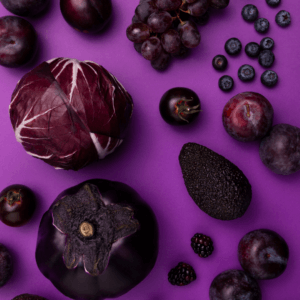 Blue and purple foods owe their rich hues to anthocyanins, which have powerful anti-inflammatory and brain-protective properties.
Blue and purple foods owe their rich hues to anthocyanins, which have powerful anti-inflammatory and brain-protective properties.
Blueberries, blackberries, and elderberries are particularly known for enhancing memory and cognitive function.
Resveratrol, found in purple grapes and red wine, has been linked to improved cardiovascular health, reduced oxidative stress, and improved mitochondrial health.
Purple cabbage and eggplant are high in antioxidants that combat free radicals, reducing the risk of chronic diseases. A 2019 study emphasized the role of anthocyanin-rich diets in reducing dementia risk, making these foods essential for brain health. Additionally, purple potatoes and plums provide fiber to support gut health and maintain a healthy weight.
Examples: Blueberries, blackberries, eggplants, purple cabbage, plums, prunes, figs, purple potatoes, elderberries, and purple carrots.
Key Nutrients: Anthocyanins, resveratrol.
How to Incorporate Blue and Purple Foods Into Your Diet:
- Top yogurt or oatmeal with fresh blueberries and blackberries.
- Roast purple potatoes as a vibrant side dish.
- Include shredded purple cabbage in salads or tacos.
White and Brown Foods
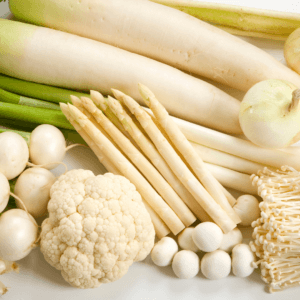 Despite their neutral appearance, white and brown foods like garlic, onions, and mushrooms pack a nutritional punch.
Despite their neutral appearance, white and brown foods like garlic, onions, and mushrooms pack a nutritional punch.
Allicin in garlic and onions supports immune health, reduces blood pressure, and has antimicrobial properties. Mushrooms are a valuable source of selenium and potassium, which are essential for cell repair and maintaining electrolyte balance.
Cauliflower, a versatile cruciferous vegetable, is rich in antioxidants and supports digestion. White beans and parsnips provide dietary fiber, promoting gut health and stabilizing blood sugar levels. A meta-analysis from 2020 showed that garlic supplementation significantly reduces cholesterol levels, further highlighting the health benefits of white foods.
Examples: Garlic, onions, mushrooms, cauliflower, parsnips, turnips, white beans, potatoes, bananas, and jicama.
Key Nutrients: Allicin, potassium, selenium.
How to Incorporate White and Brown Foods Into Your Diet:
- Sauté garlic and onions as a base for soups and sauces.
- Add mushrooms to stir-fries, omelets, or pasta dishes.
- Use cauliflower as a low-carb substitute for rice or pizza crust.
Tips to Incorporate the Rainbow Into Your Diet
Eating a diet rich in natural colors isn’t just healthy—it can be fun and endlessly creative! By planning your meals to include foods from each color group, you’ll enjoy a wide array of antioxidants, vitamins, and minerals that nourish your body.
Make it simple by prepping your fruits and vegetables ahead of time—wash, chop, and store them so they’re ready to brighten any dish.
Of course, whenever possible, choose USDA Certified Organic produce to minimize pesticide exposure.
Aim for local, seasonal options for unbeatable freshness and affordability, but don’t shy away from mixing in flash-frozen or dried varieties for convenience, affordability, and texture. (After all, certain types of flash-frozen produce can be even MORE nutritious than their fresh counterparts.)
Want some inspiration to get started? Try this easy and delicious Eat the Rainbow Salad Recipe that’s as stunning as it is satisfying!
Eat the Rainbow Salad Recipe
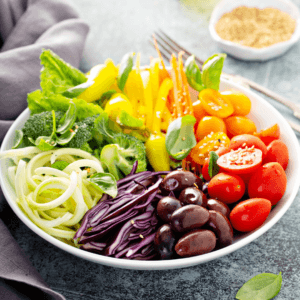 Ingredients:
Ingredients:
– 2 cups spinach, arugula, or kale (green)
– 1/2 cup cherry tomatoes (red)
– 1/2 cup shredded carrots (orange)
– 1/2 cup yellow bell peppers (yellow)
– 1/2 cup purple cabbage (purple)
– 1/4 cup green cucumbers (green)
– 1/4 cup cooked quinoa (optional, for added protein)
Dressing:
– 3 tablespoons olive oil (optional)
– 1 tablespoon lemon juice
– 1 teaspoon Dijon mustard
– 1/2 teaspoon honey or maple syrup
– Salt and pepper to taste
Instructions:
- Prepare all vegetables by washing, peeling, and chopping as necessary.
- In a large salad bowl, combine mixed greens, cherry tomatoes, shredded carrots, yellow bell peppers, purple cabbage, and cucumbers.
- If using, add cooked quinoa and crumbled feta cheese.
- In a small bowl, whisk together olive oil, lemon juice, Dijon mustard, honey, salt, and pepper to create the dressing.
- Drizzle the dressing over the salad and toss gently to combine.
- Serve immediately and enjoy the vibrant colors and flavors!
Conclusion
Adding a spectrum of colors to your plate is a simple yet powerful way to enhance your health and vitality. From the heart-protective benefits of red foods to the brain-boosting effects of purple, each color offers unique advantages.
Start small by incorporating one new color into your meals this week, and watch as your energy and wellness improve. Remember, every bite of color is a step towards a healthier, more vibrant you!
The #1 Way to Get Your Daily Dose of Antioxidants and 10 of Nature’s Other Most Potent Foods for Your Longevity? The USDA Certified Organic YOUTH FOUNTAIN
As you’ll see, chances are very high that you’re falling far short of one vital class of micronutrients (even if you’re a healthy eater).
Seeing a huge gap in the market for a highly effective supplement that provides your body these micronutrients from real-food sources — and that is also truly USDA Certified Organic and safe — Purity Woods set out to create the most effective supplement of its kind available anywhere.
And because Youth Fountain addresses this big problem facing most people today, we literally guarantee you will agree we succeeded and that you’ll quickly feel the difference!
And right now — as you’ll see right here — you’re getting Youth Fountain for up to 32% OFF with FREE U.S. shipping if you are interested!
Youth Fountain provides your body a range of powerful antioxidants from 11 of nature’s most potent real-food sources. This includes the concentrated extracts of organic beets, turmeric, acerola cherry, green tea, elderberry, triphala, cinnamon, and more.
Plus, Youth Fountain contains naturally fermented ingredients to help boost its bioavailability (meaning you get even more of the health benefits).
Yes, like all Purity Woods products, Youth Fountain is USDA Certified Organic. That means you can rest assured it’s free of synthetic ingredients and other junk you do not want in your body (such as pesticides, toxic preservatives, dyes, and hydrogenated oils that are unfortunately so common in supplements today).
Whatever you do choose, though — for the sake of your brain, heart, liver, energy and overall longevity — please do take proper care to ensure you are getting enough antioxidants. This means both in terms of volume and a wide range of antioxidants.
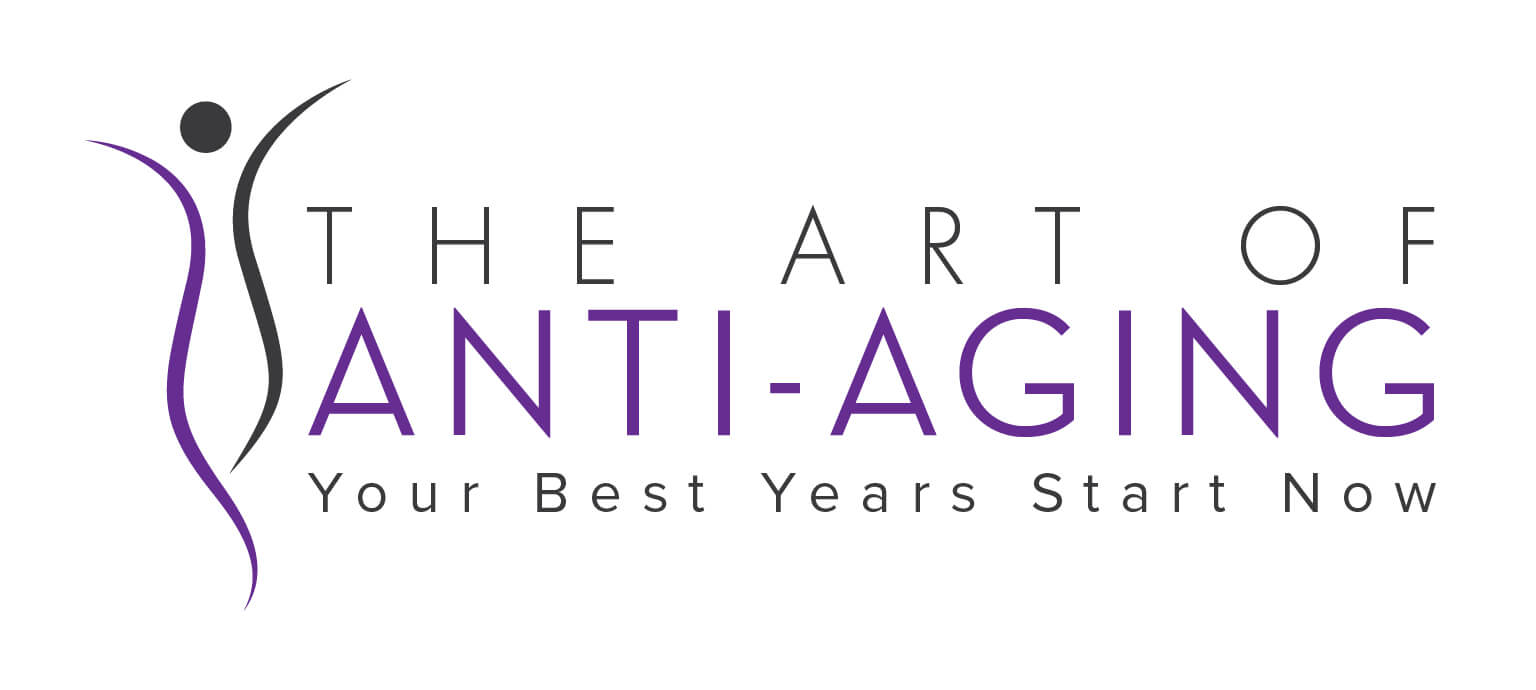

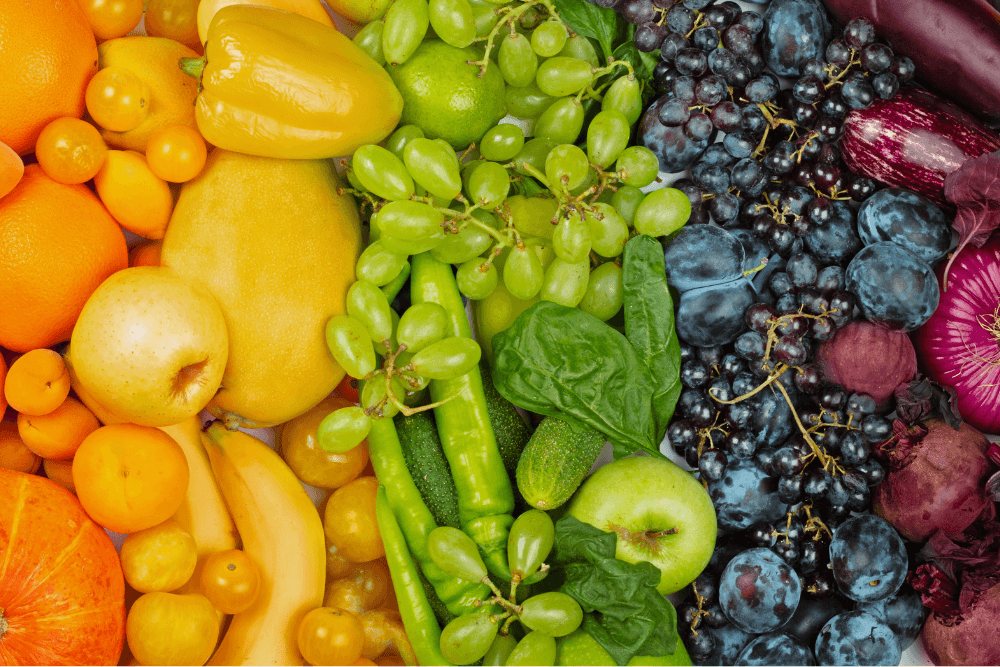
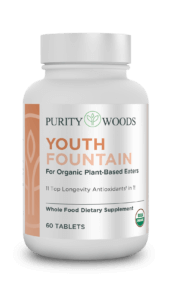 Youth Fountain is the most important supplement today if you’re concerned about your brain, heart, gut, energy, and avoiding premature aging — click here now to find out exactly why that’s true!
Youth Fountain is the most important supplement today if you’re concerned about your brain, heart, gut, energy, and avoiding premature aging — click here now to find out exactly why that’s true!
Love all your suggestions about incorporating different colored foods in my diet….which I try to do but will definitely try to use more of the ones I haven’t used. Thanks for the salad and dressing recipe also. Will definitely be making it!
Thank you!!
This is an excellent article about incorporating a variety of foods into your diet based on their colors! Very useful! Thanks so much! Love the salad and dressing recipe too! I’m going to try it!
I am also loving the information from the speakers at your most recent Anti-Aging Summit!! I’m sooo glad I purchased the book containing the 22 speakers’ transcripts! Thoroughly enjoying reading it and marking up the pages for things to refer back to again and again. Thank you!